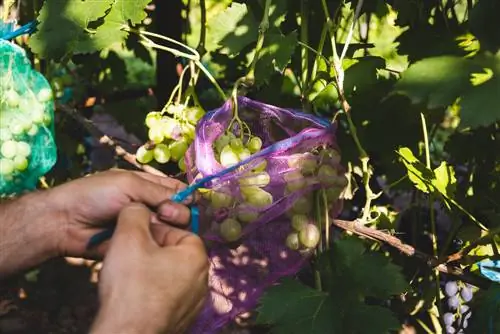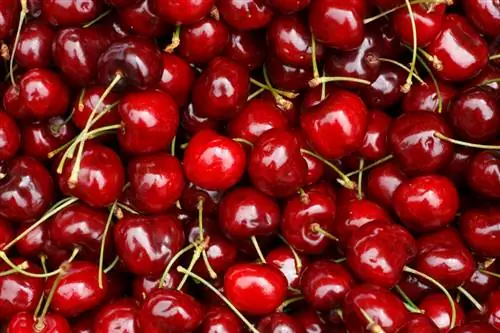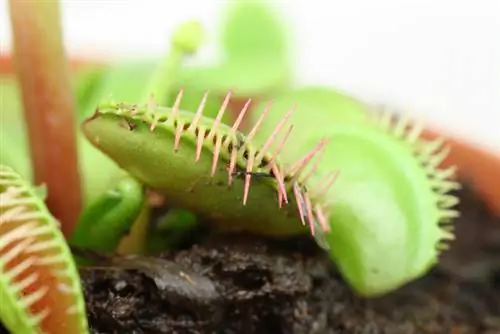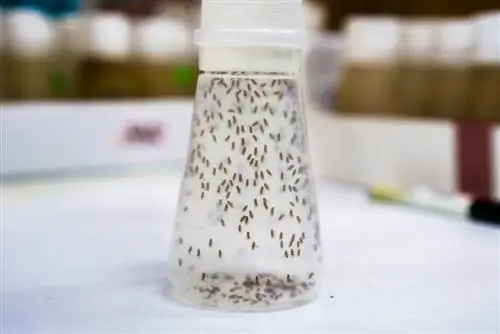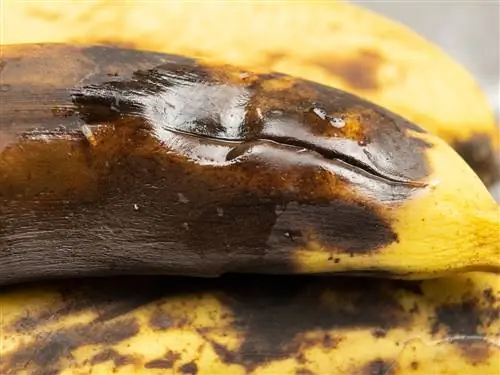- Author admin [email protected].
- Public 2023-12-29 04:51.
- Last modified 2025-01-23 11:22.
The cherry vinegar fly is increasingly giving hobby gardeners an uneasy feeling because it continues to spread. In fruit growing it can sometimes cause considerable damage. But there are ways to prevent an infestation or stop the spread.
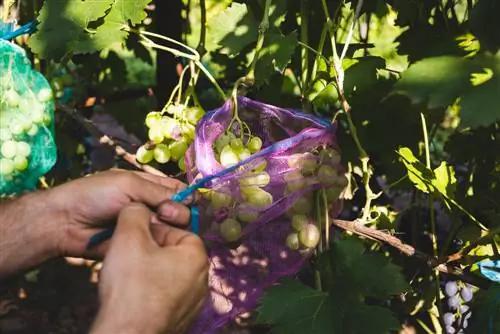
How to fight the cherry vinegar fly?
The cherry vinegar fly is a pest that lays eggs in soft-shelled fruits, causing crop losses. To combat them, you can use biological methods such as homemade traps, kaolin treatments, protective nets and preventative measures such as fruit selection and regular mowing.
What damage do cherry vinegar flies cause?
Female cherry vinegar flies lay their eggs through the sawn open shell into the flesh of previously undamaged fruit. This distinguishes the species from the native vinegar fly, which prefers to fly to overripe fruit. It cannot be seen with the naked eye whether eggs have been laid on a fruit. Research has shown that the cherry vinegar fly does not transmit vinegar bacteria to the fruit. But consequential damage is possible due to the opened fruit skin:
- Secondary pests find access points
- Feeding activity of the larva causes sap leakage, which attracts pests
- Juice residues provide breeding ground for putrefactive fungi
- quantity and quality crop losses
Excursus
Egg laying
A female cherry vinegar fly can lay between seven and 16 eggs per day. Over the course of their entire life, the number adds up to around 400. She does not proceed randomly when searching for a suitable place to lay her eggs. Research has shown that a natural coating of fungi, yeast or bacteria on the surface of the fruit favors the decision.
If a female has laid her eggs on a fruit, she marks this area. This prevents other females in the immediate area from laying their eggs. Mild temperatures and sufficiently high humidity ensure that a maggot hatches from the egg.
Damage potential
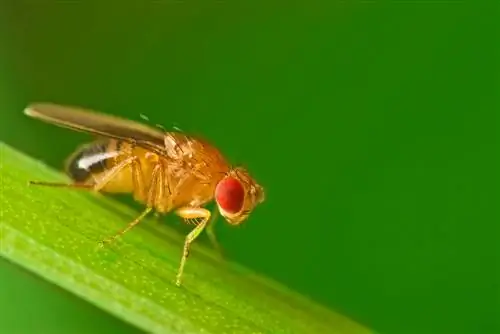
The black-bellied fruit fly (pictured here) causes more damage than the cherry vinegar fly
The cherry vinegar fly (Drosophila suzukii), which originally comes from Asia, was first observed in Germany in 2011. Over the next three years, the pest spread nationwide. The species is favored by the increasingly mild climate. When temperatures drop below zero in winter and rise sharply in summer, populations automatically reduce. Observations of the infestation in recent years have shown that the damaging potential of the vinegar fly in viticulture is lower than the damage caused by the black-bellied fruit fly (Drosophila melanogaster).
Cherry vinegar flies can cause damage in viticulture and fruit crops. Areas particularly at risk are close to forests and tall meadows.
Dangerous to humans?
If you are unsure whether the infected fruit is still edible, you should trust your senses. Look closely at the fruit and smell it. If you don't smell any unpleasant odors, try the pulp. Even freshly infected fruits containing eggs or newly hatched larvae are harmless and not harmful to he alth. In the late infestation stage, injuries with juice leakage are clearly visible and the fruit exudes a vinegar smell. Such fruits are inedible.
Handling the crop if infestation is suspected:
- only harvest apparently intact fruits
- Harvest directly at the beginning of fruit ripening
- Stop egg development by severely cooling the crop
- Heat the pulp or soak it in alcohol
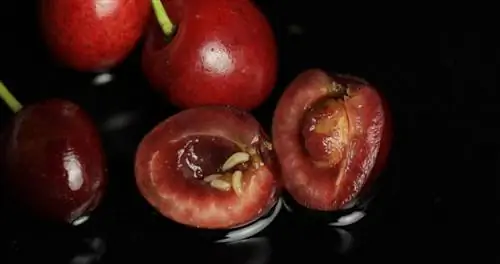
Even fruits infested with larvae can usually still be eaten
Identifying cherry vinegar flies
The Japanese cherry vinegar fly looks like a native species at first glance. It has a yellow to brown colored body and dark stripes on its belly. Cherry vinegar flies appear brighter than fruit flies. The red eyes are striking. The larvae are white in color and cylindrical in shape. They reach a size of 3.5 millimeters. While females differ from other species due to their ovipositors, males have a striking feature:
| male | Female | |
|---|---|---|
| Size | 2.6 to 2.8 millimeters | up to 3.4 millimeters |
| Wings | each wing tip with dark spot | transparent |
| Abdomen | inconspicuous | sharp-toothed egg-laying apparatus |
Fighting cherry vinegar flies
The Asian cherry vinegar fly can be controlled with insecticides. But in the private sector, chemical agents are not a solution. With suitable alternatives you can biologically ward off the fruit pest without endangering your he alth.

Build your own trap
Traps are easy to make yourself from recycled plastic cups with lids. A disposable cup for smoothies or other drinks with a capacity of 500 milliliters is ideal. Although they are not enough to completely combat the infestation, they can be used for control. Craft instructions:
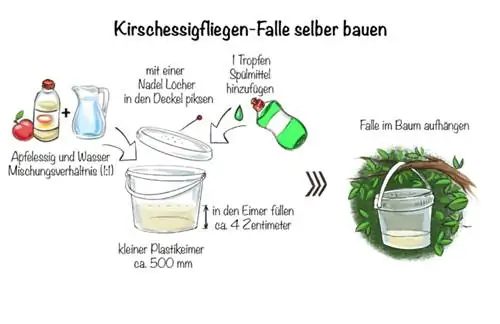
- Prick three to four millimeter holes in the lid
- Mix apple cider vinegar and water (1:1) and pour into the cup to a height of four centimeters
- Add a drop of detergent
- Hang the trap in the shade at the level of the fruit
- Use cable ties for fastening
It is necessary to place it as early as possible before the fruit ripens in order to detect the infestation in good time. The small openings allow Drosophila species to enter the trap, while unwanted side catches from larger insects are prevented. Prepare a double set of traps so you can easily swap and renew the containers.
Kaolin
Kaolin is better known as porcelain or white clay. The main component is kaolinite, which from a chemical point of view is an aluminum s alt of silica. The finely ground powder, dissolved in water, deters cherry vinegar flies from laying eggs after at least four sprays. The effect lasts until the next rain. If the flies are dusted with the agent, the fine particles adhere to the body and trigger an excessive urge to clean. The flies forget to eat and neglect reproduction.
Advantages:
- He alth: no danger to people and pets
- Species diversity: no killing but only deterrent effect
- Effectiveness: uniform particles form a uniformly dense spray coating
Nets
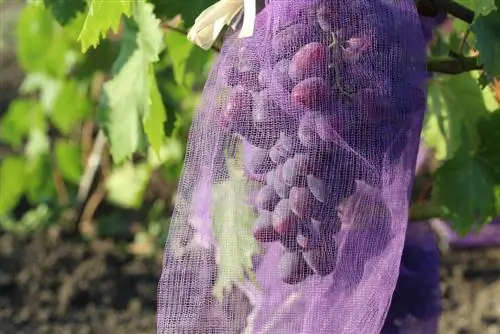
Fine-mesh nets keep the cherry vinegar fly away from the fruit
Protective nets are ideal for private use if you want to protect isolated bushes from infestation by the cherry vinegar fly. It is important that the net has a maximum mesh size of 1.2 millimeters and is hung completely over the bush. Even the smallest gap allows access. The disadvantage of this variant is that opening the nets can allow flies to get to the bush. Therefore, only open the covers on hot and dry days when there are no cherry vinegar flies in the air.
Tip
To increase protection against the influx of cherry vinegar flies, you should, if possible, cultivate the covered bushes in a greenhouse.
Preventive measures
If possible, you should moderately defoliate affected fruit bushes. In this way, the trees are better ventilated and more sunlight falls inside. Cherry vinegar flies find dry and sunny bushes less attractive. If an infestation is suspected, the surrounding vegetation should also be kept as low as possible to promote warm and dry conditions.
What you can do:
- Thin fruit before ripening and remove damaged fruit
- do not leave any fallen fruit lying around as the smell attracts cherry vinegar flies
- Mulch the soil to accelerate rotting processes
Tip
To identify an infestation, you can store fruit in a tight mesh bag and monitor it over the next few days. In warm temperatures, the flies hatch within a short time.
Which plants do cherry vinegar flies attack?
Drosphila suzukii is not picky about host plants. Females prefer to lay their eggs on soft-shelled fruits. Red grape varieties with a compact structure and thin skin, as well as cherries, are particularly attractive. Because of the heavy reproduction in the summer months, late-ripening fruit varieties are also at risk. The cherry vinegar fly also attacks wild berry bushes such as raspberries and blackberries. Apples and pears are only affected if the fruit peel is already damaged.
Frequently asked questions
Does fruit lime help against the cherry vinegar fly?
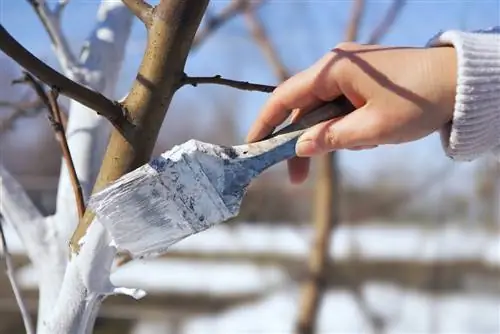
Fruit lime is ineffective against the cherry vinegar fly
Fruit lime is a milk of lime that is used as a white coat for fruit trees. It contains slaked lime and helps against fungal diseases. No effect was found in controlling cherry vinegar flies. Glued color panels and products with lavender oil are equally ineffective.
What does the infestation look like on raspberries and blackberries?
As part of a research project by the Bavarian State Ministry of Food, Agriculture and Forestry (StMELF), it was determined at which stage of maturity cherry vinegar flies preferred to lay their eggs on raspberries and blackberries.
While no eggs were found in unripe blackberries with a slight red color, almost all samples of raspberries that were beginning to turn red were infected. The redder the blackberries became, the more eggs there were in the pulp. The number of eggs in ripening raspberries, however, decreased slightly. In both cases, the females preferred to seek out fruits that were fully ripe.
Can I see a cherry vinegar fly infestation early?
It is difficult to detect an infestation in time. It cannot be seen with the naked eye whether there are eggs in the pulp. Only the presence of pupae can be determined through a magnifying glass. The pupae have two appendages that protrude from the fruit shell. Typical for the pupae of the vinegar fly are star-shaped appendages, which do not occur in pupae of related species.
How do cherry vinegar flies live?
The species prefers mild temperatures and temperate conditions. If the thermometer rises above 30 degrees, insect activity is restricted. At temperatures above 32 degrees, reproduction no longer takes place. Adult flies survive the winter in a frost-free hiding place. They wake up in spring when temperatures rise to ten degrees. Due to these requirements, the species was able to spread across large parts of Europe.

